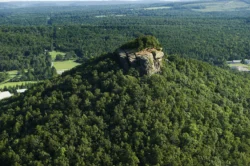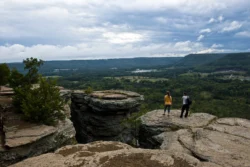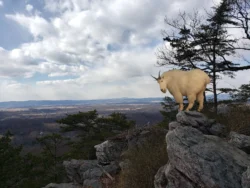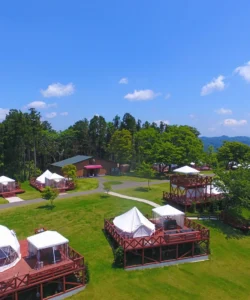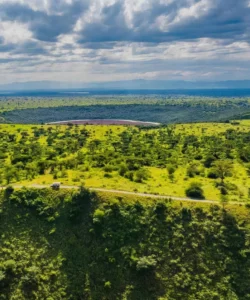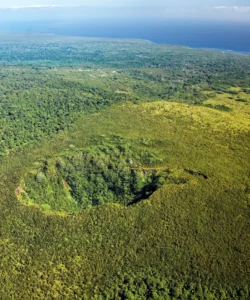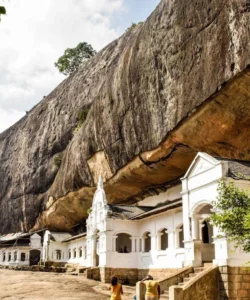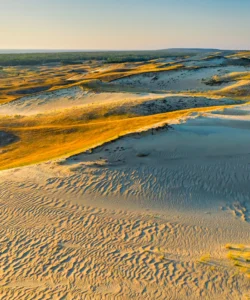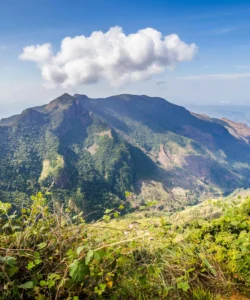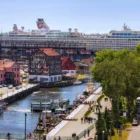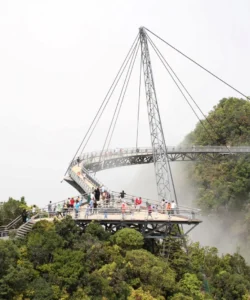Sugarloaf Mountain (Portuguese: Pão de Açúcar) is a towering, conical peak located at the mouth of Guanabara Bay in Rio de Janeiro, Brazil. Composed of granite and quartz, it rises 396 meters (1,299 feet) directly from the ocean, creating a dramatic and iconic landmark that defines Rio’s breathtaking coastline. Famous for its unique shape, the panoramic views it offers, and the thrilling cable car ride that ascends its slopes, Sugarloaf Mountain is a quintessential symbol of Rio and a UNESCO World Heritage site (as part of the “Rio de Janeiro: Carioca Landscapes between the Mountain and the Sea”).
Name: Sugarloaf Mountain (Pão de Açúcar, literally “Sugar Loaf Bread”)
Address: Avenida Pasteur, 520 – Urca, Rio de Janeiro, Brazil. This is the address for the cable car station at Praia Vermelha (Red Beach).
How to get there:
Reaching Sugarloaf Mountain, involves a significant international journey to South America, followed by domestic travel to Rio de Janeiro, and then an ascent via its famous cable car:
- From Rio de Janeiro to Sugarloaf Mountain (Praia Vermelha Cable Car Station):
- By Metro + Bus: Take the subway to Botafogo Station (Line 1 or 2). From there, you can catch a connecting bus (like 513 or 511/512) to Praia Vermelha (Red Beach), which is where the Sugarloaf cable car station is located.
- By Uber/Taxi: The most convenient way. Simply input “Praia Vermelha” or “Estação do Bondinho” (the cable car station) into your ride-hailing app or tell a taxi driver. It’s an inexpensive option within Rio.
- By Public Bus: Various local bus lines serve the Urca neighborhood, where the cable car station is.
- Walking/Hiking: It is possible to hike up Morro da Urca (the first mountain stop on the cable car journey) via the Claudio Coutinho Track (Praça General Tiburcio, 125). This path offers a free ascent to the first level, from which you then need to purchase a ticket for the cable car to Sugarloaf’s summit. This is popular for those wanting a physical challenge and a chance to spot wildlife.
Operating Hours and Entrance Fee:
- Operating Hours (Parque Bondinho Pão de Açúcar – Sugarloaf Cable Car Park):
- Monday to Thursday: 9:00 AM – 8:00 PM (last cable car boarding at 6:30 PM).
- Friday to Sunday: 8:30 AM – 8:30 PM (last cable car boarding at 7:00 PM).
- Ticket offices usually close earlier, around 6:30 PM daily. It’s always best to check the official Parque Bondinho website for the most current times, as they can vary.
- Entrance Fee (as of late 2024/early 2025, subject to change – always check official website):
- Regular Adult Cable Car Ticket: R$ 185.00 (approx. $37 USD). This includes the full round-trip journey.
- Fast Pass/Skip-the-Line Ticket (Adult): R$ 285.00 (approx. $57 USD). This allows you to bypass the queues.
- Children (3-12 years), Youth (13-21 years), Seniors (60+), Students: Often receive a 50% discount on regular tickets (approx. R$ 92.00). Children under 3 are usually free.
- It is highly recommended to buy tickets online in advance, especially during peak seasons or if you plan to visit around sunset, to save time and avoid long queues.
Landscape and Architecture:
Sugarloaf Mountain is a natural geological marvel whose architecture is defined by its dramatic form and the ingenious cable car system that ascends it:
- Monolithic Granite-Quartz Peak: The mountain is a massive, smooth-sided block of granite and quartz, rising abruptly from the ocean. Its distinctive conical shape, resembling a traditional sugar loaf, is instantly recognizable.
- Urca Hill (Morro da Urca): The cable car journey involves two stages. The first stage goes from Praia Vermelha to Morro da Urca, a smaller, lower hill (220 meters / 722 ft). Morro da Urca offers a large public area with shops, restaurants, an amphitheater, and excellent intermediate views of Rio.
- Cable Car System (Bondinho do Pão de Açúcar): This is an integral part of the experience. The iconic glass-walled cable cars (locally known as “bondinho”) glide smoothly between Praia Vermelha, Morro da Urca, and finally to the summit of Sugarloaf Mountain. The system was first inaugurated in 1912, making it one of the oldest operating cable car systems in the world.
- Panoramic Views: From both Morro da Urca and the summit of Sugarloaf, visitors are treated to unparalleled, sweeping panoramic views of Rio de Janeiro. These vistas include:
- The entire Guanabara Bay, with its islands.
- Copacabana and Ipanema beaches.
- The Christ the Redeemer statue on Corcovado Mountain.
- The lush Tijuca National Park.
- The city’s sprawling urban landscape, including the Botafogo cove and the entrance to the bay.
- Lush Surrounding Vegetation: The base of the mountain and the slopes of Morro da Urca are covered in lush Atlantic Forest vegetation, part of the broader Tijuca Forest National Park, providing a natural, green backdrop.
- Beaches: Praia Vermelha (Red Beach) at the base of the mountain is a picturesque sandy cove popular for swimming and relaxation, framed by the mountains.
- Architectural Features (Minimal): Beyond the cable car stations, the summit areas have minimal built structures, mostly viewing platforms, gift shops, and restaurants, designed to maximize the natural views.
What makes it famous:
Sugarloaf Mountain is famous for:
- Iconic Symbol of Rio de Janeiro: Along with Christ the Redeemer, it is one of the most recognizable and frequently photographed landmarks of Rio, appearing in countless postcards and films.
- Thrilling Cable Car Ride: The two-stage cable car journey is a major attraction in itself, offering a smooth, quiet ascent with progressively more spectacular views. It was the first Brazilian cable car and the third in the world.
- Breathtaking Panoramic Views: The unparalleled 360-degree vistas from its summit are legendary, especially during sunrise and sunset, making it a top global viewpoint.
- UNESCO World Heritage Site: Recognized as part of the “Rio de Janeiro: Carioca Landscapes between the Mountain and the Sea” UNESCO site, celebrating the extraordinary fusion of natural and urban landscapes.
- Unique Geological Formation: Its distinct “sugarloaf” shape, formed by granite and quartz, makes it a geological marvel.
- Historical Significance: The cable car system has a long and pioneering history, inaugurated over a century ago.
- Romantic Destination: Like Christ the Redeemer, it’s a popular spot for couples due to its stunning beauty and romantic ambiance.
Differences from some other wonders:
Sugarloaf Mountain distinguishes itself from other famous mountains and viewpoints in several key ways:
- Sea-Level Ascent: Unlike mountains accessed from a higher base (e.g., Christ the Redeemer on Corcovado Mountain, which has a higher base altitude), Sugarloaf rises directly from sea level, creating a dramatic and continuous ascent from the ocean’s edge to its summit.
- “Twin Peak” Experience via Cable Car: The unique two-stage cable car system that stops at Morro da Urca before reaching Sugarloaf provides two distinct viewing experiences and leisure areas, essentially offering a “two-for-one” mountain visit.
- Granite Monolith Shape: Its perfectly conical and smooth “sugar loaf” shape, a result of specific geological erosion, is highly distinctive compared to other jagged peaks or broader mountain ranges.
- Integral Cable Car to Identity: While many mountains have cable cars, the Bondinho do Pão de Açúcar is so iconic and historically significant that it’s almost as famous as the mountain itself, the experience of the ride being central to the attraction.
- Urban-Coastal Integration: Its location right at the mouth of a major urban bay (Guanabara Bay), providing direct views of a vast urban landscape, sprawling beaches, and other natural landmarks (like Christ the Redeemer), creates a particularly rich visual tapestry distinct from mountains in more remote settings.
- Contrast with Christ the Redeemer: While both are iconic Rio landmarks, Sugarloaf offers different angles and focuses on the city and bay, complementing the Christ the Redeemer experience without being redundant.
In essence, Sugarloaf Mountain is a breathtaking and truly unique wonder, a colossal natural sculpture that offers an unparalleled journey and an unforgettable panorama of Rio de Janeiro’s vibrant blend of natural beauty and urban life.



